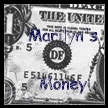Welcome to Flashback Fridays. Every now and then -- on a Friday, obviously -- I'll re-post something I wrote way back when.
This post is from September 28, 2007. I still think switching to some kind of an envelope system of budgeting is one of the best thing we ever did for our personal finances. I'm still a huge fan of Budget for Windows by Snowmint. There are other programs that will do identical or similar things for you; this is just the one I chose and I love it.
**********
Paying the bills...the actual act of sending the payments...seems to be a popular topic recently on several of the personal finance blogs and websites I frequent.
By simply staying on top of your bills and keeping your checkbook balanced, you can avoid unnecessary late fees and overdraft charges. Anyone who even occasionally forgets to pay a bill on time or forgets to record an ATM withdrawal, knows these fees can add up in a hurry. I used to do both until I realized that it was because I wasn't organized pay my bills or balance my checkbook often enough.
Getting organized, for me, happened in two distinct steps. First was keeping a list each month of the bills I needed to pay, when they were due, and when I should send the payment. I keep mine simple by listing bills on a sheet of paper in a small spiral or steno notebook, then drawing a line through each bill as I pay it. At the end of the month, I write everything down on the next sheet in the book. Of course, there are more elaborate systems; I think whatever works for someone is the system they should use.
My list helped me to remember to pay everything on time without leaving anything out, but it did nothing to ensure that I would have enough money to pay a bill when it came due. Over and over, I read about the good ol' fashioned envelope method of budgeting, in which you cash your paycheck and distribute the whole of it into physical envelopes marked with categories such as groceries, utilities, mortgage, car payment, and so forth. I liked the idea, but not the execution. I simply wasn't comfortable with the idea of carrying around that much cash or that many envelopes.
Instead, I did the same thing, but only on paper. Using a standard 13-column ledger, I "distributed" our money into "envelopes", one per column, and tracked all of our spending.
The first step was to decide how much of our income should be allotted to the various envelopes. We want enough in each envelope that we don't need to worry if bills will be covered, but not so much that money is just sitting in an envelope when it could literally be better spent elsewhere.
Second, we decided to go "cashless" for the most part. Whenever possible, we pay for goods and services using our debit card, online bill-paying and the occasional credit card transaction. We love to go to garage sales, and those obviously require cash, and we pay our daycare provider with a check each week, but at least 95% of our spending is done electronically.
Third, we also began getting (and saving) a receipt for EVERYTHING we buy, even if it's just a pack of gum or a soda at the gas station.
On a semi-regular schedule, I would round up all of our receipts, make sure everything was recorded in our checkbook correctly, then enter ALL of our transactions into the ledger. If everything was entered correctly, and my math was error-free, the checkbook and the ledger would balance and both would agree with the monthly bank statement.
This worked very well, and almost immediately our financial situation improved. Everything was getting paid on time, our bank account wasn't overdrawn, and we could tell exactly where our spending strengths and weaknesses were. But the work involved in setting it up and keeping it up manually was daunting. I easily spent a 3-4 hours at a time working on it, and I often failed to maintain it every week. If I made a mistake in my figures, it could take hours or even days to locate and correct. But because of the difference it made for us, I was unwilling to give it up.
At some point, I was fortunate enough to read about a computer programs that would do automatically what I'd been doing manually. There are no doubt many of these programs available, but the one I read about was called Mvelopes. I'd read great things about Mvelopes, but instead of it being an application that I could download or purchase on a CD, it required a membership fee (currently ranging between $7.90 and $13.20 a month). I didn't want to pay the fee, so I continued to search.
I found another program, its name long forgotten, with a free trial download. It downloaded fine, but I found it cumbersome to work with and full of glitches. Then I found one called Budget for Windows by Snowmint Creative Solutions. It, too, had a free trial download. I downloaded it and had it completely set up in about half an hour. I absolutely loved it and purchased the download right away. It's easy to use, has a helpful tutorial, free upgrades and is very affordable. It even has colorful representations of envelopes, making it as close to the "envelope system" as you can get without actual paper envelopes.

t about the same time, our bank made online account viewing and bill paying available, which I signed up for immediately.
With these tools in place -- my list of bills, Budget for Windows and online banking -- I can now track our income and spending very quickly. I take on our budgeting "chore" once a week now. The steps are the same. I cross off the bills from my list as I pay them, except I pay them electronically now. We are still cashless and still save all of our receipts, which I record in our checkbook. Only now, I also look at our transactions online to make sure that no receipts have accidentally got lost and no online purchases or deposits (eBay, etc.) have been forgotten. When my checkbook balances with the bank's figures, then I enter everything into Budget. When it balances with the checkbook and bank, I not only know my math is correct, but I also know exactly how much money we have available and what it's been set aside for.
Paying bills and balancing the checkbook now takes about 20 minutes each week, and I suppose it's geeky to say, I actually look forward to it. At the very least, I don't dread it the way I once did.
BTW, when our old computer crashed about a year ago, I had back-ups of our working Budget files but not the application itself. I ended up purchasing another download, but within a day I'd found the receipt and download code from my original purchase. I emailed Snowmint and they immediately refunded my second purchase and allowed me to use my original download code. That's excellent customer service.
This isn't a sponsored post or anything like that. Just my personal endorsement of a product that, along with a couple of habit changes, made a huge improvement in our lives.


















2 comments:
That program sounds really great! I need to do something like that rather than having an anxiety attack twice a month...
Right now I keep track of all our bills in a spreadsheet. It's not working for me... But it's comfy.
I need to do something else.
absolutely right that folks should just find whatever works for them. glad to hear about this program that works for you...peace of mind all for a one-time download fee. gotta love that!
Post a Comment